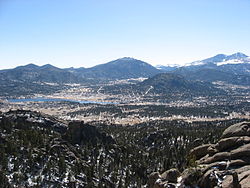Estes Park, Colorado
| Town of Estes Park, Colorado | |
|---|---|
| Statutory Town | |

Panorama of Estes Park as seen from Lumpy Ridge
|
|
 Location of Estes Park in Larimer County, Colorado |
|
| Coordinates: 40°22′38″N 105°31′32″W / 40.377117°N 105.525514°WCoordinates: 40°22′38″N 105°31′32″W / 40.377117°N 105.525514°W | |
| Country | United States |
| State | Colorado |
| County | Larimer |
| Founded | 1859 |
| Incorporated (town) | April 17, 1917 |
| Government | |
| • Type | Statutory Town |
| • Mayor | Todd A. Jirsa |
| Area | |
| • Total | 5.9 sq mi (15.2 km2) |
| • Land | 5.8 sq mi (15.1 km2) |
| • Water | 0.1 sq mi (0.1 km2) 0.85% |
| Elevation | 7,522 ft (2,293 m) |
| Population (2010) | |
| • Total | 5,858 |
| • Density | 929.5/sq mi (359.1/km2) |
| Time zone | MST (UTC-7) |
| • Summer (DST) | MDT (UTC-6) |
| ZIP Codes | 80517 |
| Area code(s) | 970 |
| INCITS place code | 0825115 |
| GNIS feature ID | 0204674 |
| Website | estes.org |
The Town of Estes Park /ˈɛstɪs/ is a statutory town in Larimer County, Colorado, United States. A popular summer resort and the location of the headquarters for Rocky Mountain National Park, Estes Park lies along the Big Thompson River. Estes Park had a population of 5,858 at the 2010 census. Landmarks include the Stanley Hotel.
Before Europeans came to the Estes Park valley, the Arapaho Indians lived there in the summertime and called the valley "the Circle." When three elderly Arapahoes visited Estes Park in 1914, they pointed out sites they remembered from their younger days. A photograph at the Estes Park Museum identified the touring party as Shep Husted, guide; Gun Griswold, a 73-year-old judge; Sherman Sage, a 63-year-old chief of police; Tom Crispin, 38-year-old reservation resident and interpreter; Oliver W. Toll, recorder; and David Robert Hawkins, a Princeton student.
In the 1850s, the Arapaho had spent summers camped around Mary's Lake, where their rock fireplaces, tipi sites, and dance rings were still visible. They also recalled building eagle traps atop Long's Peak to get the war feathers coveted by all tribes. They remembered their routes to and from the valley in detail, naming trails and landmarks. They pointed out the site of their buffalo trap, and described the use of dogs to pack meat out of the valley. Their recollections included a battle with Apaches in the 1850s, and fights with Utes who came to the area to hunt bighorn sheep, so all three of those tribes used the valley's resources.
Whites probably came into the Estes Park valley before the 1850s as trappers, but did not stay long. The town is named after Missouri native Joel Estes, who founded the community in 1859. Estes moved his family there in 1863. One of Estes' early visitors was William Byers, a newspaper editor who wrote of his ascent of Long's Peak in 1864, publicizing the area as a pristine wilderness.
...
Wikipedia
